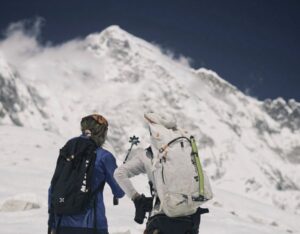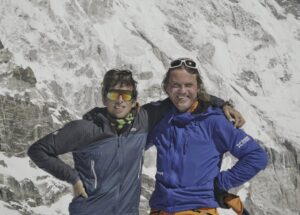The team led by Andrey Vasiliev is progressing on Cho Oyu’s SSW ridge (or SW, as they identify it). Yesterday, the team returned to their base in Gokyo village after six days on the mountain.
They have climbed the difficult lower section of the ridge and are very close to the huge high-altitude plateau leading to the summit area. From there, they will make their final push to the summit of Cho Oyu.
In contrast to the comparatively straightforward normal route up Cho Oyu from the Tibetan side, the Nepal side, where the Russians are, is difficult and technical. It has only four completed routes, all highly challenging.
The team is working in the classical style of the big Russian Himalayan expeditions, although there are only five of them. They work in two shifts, with Shipilov-Kondrashkin and Vasiliev-Klimenko-Eiseman alternating the rope fixing along the route.
In order to reach the higher plateau, the climbers will need to overcome Lungsampa Peak (6,528m), which is right in the way.

The Russian route is the red line up the buttress. The arrow points to the summit of 6,528m Lungsampa Peak, a significant milestone on the way to the summit. Route map: Andrey Vasiliev/RMF
Lungsampa barrier
The weather worsened last weekend, with thick fog making progress difficult up the rocky terrain at 6,200m. Nevertheless, on Monday, Vasiliev’s group reached 6,500m, close to Lungsampa’s summit altitude. They then descended to 6,400m, where they pitched a tent for the night. Yesterday, they all returned to Gokyo.

The Russians’ bivy at 6,400m. Photo: Andrey Vasiliev/RMF
“We don’t know if we will have to summit Lungsampa or if we will find a pass without having to reach the highest point,” Vasiliev told ExplorersWeb from Gokyo. “It is not so important, after all — it’s just 28m.”
The Russian Mountaineering Federation has two teams, one on Cho Oyu and a smaller one on Dhaulagiri, to commemorate both its centenary and that of the Ministry of Sports. The Dhaulagiri team, led by Roman Abildaev, is on the normal route with no oxygen or sherpas. They plan to begin their summit push on Friday.






